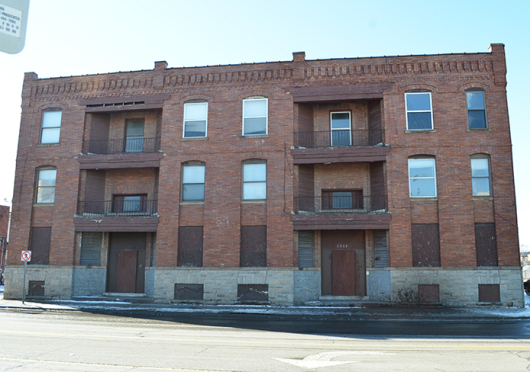
Abandoned apartment buildings, such as the one pictured on the corner of North High Street and 9th Avenue, are scheduled to undergo renovations. Credit: Robert Scarpinito / Lantern reporter
Some abandoned buildings in the University District might soon be developed as off-campus housing, pending approval from the city.
Buckeye Real Estate has proposed a plan to be reviewed by Columbus City Council to redevelop two buildings at 1513 N. High St. that are set to be ready for leasing by August 2016, according to the company’s owner.
The company is set to renovate two apartment buildings on the corner of West Ninth Avenue and North High Street, across the street from Wendy’s. A two-story parking garage is also going to be built behind the apartments, said Wayne Garland, owner of Buckeye Real Estate.
Buildings farther west toward 44 W. Ninth Ave. will also be developed in this proposal, Garland said.
Garland said he hopes to begin construction by April after creating full construction drawings and getting the proper permits and approval from Columbus City Council.
The building will include 36 units and 70 bedrooms, and more than 80 parking spots will be available, Garland said.
Garland also said the Buckeye Real Estate office at 48 E. 15th Ave. will move to the new location at West Ninth Avenue and North High Street once construction is complete.
“Part of it is, I’ve always wanted to have a High Street office,” Garland said. “We only have 16 parking spaces at 15th Avenue, but that isn’t nearly as much as I think we can provide down there.”
Garland said the current plan is to renovate the buildings so that they are in a liveable condition rather than remove the structures completely.
The buildings are currently abandoned and boarded up.
“It’d be cheaper to tear them down, but I think that’s a disservice to the community and to beautiful old architecture,” Garland said. “We’re just going to reposition them and reuse them as new modern housing units.”
The plan received approval from the University Area Review Board and then the University Area Commission, and it will seek approval from the city either later in February or early March, Garland said.
The proposal went to the UARB first to have its design approved, and the UAC then approved it for a parking variance, which had to be done because the area was not originally designated for parking garages, said Susan Keeny, first vice president and zoning committee chair of the UAC.
“It’s the kind of project that we would love to see more of in the university area because this one is working with existing historical (buildings),” Keeny said. “They’re maintaining the integrity of those two buildings … It really respects the scale of the neighborhood it’s in.”
Garland said he first submitted the proposal to the university in 2011.
“We’re very pleased to be able to be involved in that site, and hopefully we do the community proud with it,” Garland said.


